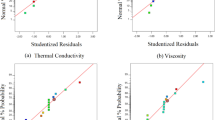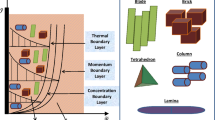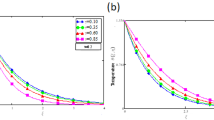Abstract
In contemporary times, there has been a significant focus among researchers on hybrid nanofluids derived from oils, owing to their remarkable and substantial utility in the domains of engineering, mechanics, and industrial applications. The aim of this research is to determine the impact of incorporating tantalum and nickel nanoparticles in mineral oil on thermal characteristics and flow patterns, with the objective of predicting possible improvements. The dependence of the role of both nanoparticles on their shapes is evaluated for column, platelet, lamina, cylinder, and tetrahedron-type shapes. This work analyzes the thermal performance of two different nanofluids individually made of tantalum and nickel nanoparticles while also examining the synergistic effects produced due to the simultaneous suspension of these particles. A profound understanding of the intricate flow dynamics and thermal energy transfer phenomena along a vertical surface holds paramount importance in the pursuit of optimizing heat exchange procedures, formulating effective cooling systems, and designing thermally efficient devices. Furthermore, it contributes to the advancement of climate modeling, the precision of weather forecasting, and the refinement of the operational effectiveness of solar thermal systems. The basic mathematical model is formulated subject to free convection, time-dependent flow and heat conditions, and thermal radiation. This governing system is made non-dimensional to lessen the intricacy and provide the basis for the utilization of fractional operators. In order to assess the effectiveness of fractional modeling techniques, constant proportional Caputo (CPC) and Atangana–Baleanu (ABC) derivatives are operated for the model generalization. Most of the time, solving fractional models via an analytic method are not a feasible technique because it produces extremely complex and implicit mathematical expressions. However, in this study, the Laplace transform is served as a solution procuring technique, and series and integral form exact solutions are extracted for CPC and ABC derivative-based models, respectively. To interpret modifications in thermal and velocity patterns arising from diverse physical phenomena, numerous graphical depictions of exact solutions are communicated. Moreover, the implications of varying a number of critical factors, including the fractional parameter, nanoparticles’ shapes and proportions, and radiation term, on shear stress and thermal productivity of the hybrid nanofluid are discussed using the tabulated findings. On comparing shape effects and individual suspensions of considered nanoparticles, it is observed that lamina shape and nickel nanoparticles are relatively more effective regarding the improvement of thermal performance. The model based on the CPC derivative yields lower profiles of temperature and flow functions as compared to the ABC derivative-based model. The results indicate that introducing homogeneous proportions of tantalum and nickel nanoparticles into mineral oil raises its heat-transferring capacity by up to 47.60%. These findings suggest that the examined hybrid nanofluid performs extremely well as a lubricant and a cooling agent.










Similar content being viewed by others
References
Bahmani MH, Sheikhzadeh G, Zarringhalam M, et al. Investigation of turbulent heat transfer and nanofluid flow in a double pipe heat exchanger. Adv Powder Technol. 2018;29(2):273–82.
Miles A, Bessaïh R. Heat transfer and entropy generation analysis of three-dimensional nanofluids flow in a cylindrical annulus filled with porous media. Int Commun Heat Mass Transf. 2021;124: 105240.
Farooq A, Rehman S, Alharbi AN, et al. Closed-form solution of oscillating Maxwell nano-fluid with heat and mass transfer. Sci Rep. 2022;12(1):12205.
Jamshed W, Goodarzi M, Prakash M, et al. Evaluating the unsteady Casson nanofluid over a stretching sheet with solar thermal radiation: an optimal case study. Case Stud Therm Eng. 2021;26: 101160.
Ferhi M, Djebali R, Abboudi S, Al-kouz W. Magnetohydrodynamic (MHD) convective nanofluid flow, heat transfer and irreversibility analysis in a horizontal micro tall cavity with heat sources in the slip regime. J Nanofluids. 2022;11(4):510–27.
Mehta B, Subhedar D, Panchal H, Said Z. Synthesis, stability, thermophysical properties and heat transfer applications of nanofluid-a review. J Mol Liq. 2022;365: 120034.
Kumar YS, Hussain S, Raghunath K, et al. Numerical analysis of magnetohydrodynamics Casson nanofluid flow with activation energy, Hall current and thermal radiation. Sci Rep. 2023;13(1):4021.
Said Z, Arora S, Farooq S, et al. Recent advances on improved optical, thermal, and radiative characteristics of plasmonic nanofluids: academic insights and perspectives. Sol Energy Mater Sol Cells. 2022;236: 111504.
Rasool G, Wakif A, Wang X, et al. Numerical passive control of alumina nanoparticles in purely aquatic medium featuring EMHD driven non-Darcian nanofluid flow over convective Riga surface. Alexandria Eng J. 2023;68:747–62.
Eshgarf H, Nadooshan AA, Raisi A. A review of multi-phase and single-phase models in the numerical simulation of nanofluid flow in heat exchangers. Eng Anal Bound Elem. 2023;146:910–27.
Wang X, Rasool G, Shafiq A, et al. Numerical study of hydrothermal and mass aspects in MHD driven Sisko-nanofluid flow including optimization analysis using response surface method. Sci Rep. 2023;13(1):7821.
Maskeen MM, Zeeshan A, Mehmood OU, Hassan M. Heat transfer enhancement in hydromagnetic alumina-copper/water hybrid nanofluid flow over a stretching cylinder. J Therm Anal Calorim. 2019;138:1127–36.
Nadeem S, Abbas N, Malik MY. Inspection of hybrid based nanofluid flow over a curved surface. Comput Methods Programs Biomed. 2020;189: 105193.
Hanif H, Khan I, Shafie S. Heat transfer exaggeration and entropy analysis in magneto-hybrid nanofluid flow over a vertical cone: a numerical study. J Therm Anal Calorim. 2020;141(5):2001–17.
Khashi’ie NS, Arifin NM, Sheremet M, Pop I. Shape factor effect of radiative Cu-Al2O3/H2O hybrid nanofluid flow towards an EMHD plate. Case Stud Therm Eng. 2021;26: 101199.
Khazayinejad M, Nourazar SS. Space-fractional heat transfer analysis of hybrid nanofluid along a permeable plate considering inclined magnetic field. Sci Rep. 2022;12(1):5220.
Jayaprakash MC, Alsulami MD, Shanker B, Kumar RSV. Investigation of Arrhenius activation energy and convective heat transfer efficiency in radiative hybrid nanofluid flow. Waves Random Complex Media. 2022;1–13.
Yasmin H, Giwa SO, Noor S, Sharifpur M. Experimental exploration of hybrid nanofluids as energy-efficient fluids in solar and thermal energy storage applications. Nanomaterials. 2023;13(2):278.
Ali B, Hussain S, Shafique M, et al. Analyzing the interaction of hybrid base liquid C2H6O2-H2O with hybrid nano-material Ag-MoS2 for unsteady rotational flow referred to an elongated surface using modified Buongiorno’s model: FEM simulation. Math Comput Simul. 2021;190:57–74.
Preeti Ojjela O. Numerical investigation of heat transport in alumina-silica hybrid nanofluid flow with modeling and simulation. Math Comput Simul. 2022;193:100–22.
Rasool G, Wang X, Yashkun U, et al. Numerical treatment of hybrid water based nanofluid flow with effect of dissipation and Joule heating over a shrinking surface: stability analysis. J Magn Magn Mater. 2023;571: 170587.
Qureshi MZA, Faisal M, Raza Q, et al. Morphological nanolayer impact on hybrid nanofluids flow due to dispersion of polymer/CNT matrix nanocomposite material. AIMS Math. 2023;8(1):633–56.
Caputo M, Fabrizio M. A new definition of fractional derivative without singular kernel. Progr Fract Differ Appl. 2015;1:73–85.
Atangana A, Baleanu D. New fractional derivatives with nonlocal and non-singular kernel: theory and application to heat transfer model. Therm Sci. 2016;4(2):763–9.
Giusti A, Colombaro I. Prabhakar-like fractional viscoelasticity. Commun Nonlinear Sci Numer Simulat. 2018;56:138–43.
Ahmad Z, El-Kafrawy SA, Alandijany TA, et al. A global report on the dynamics of COVID-19 with quarantine and hospitalization: a fractional order model with non-local kernel. Comput Biol Chem. 2022;98: 107645.
Fallahgoul H, Focardi S, Fabozzi F. Fractional calculus and fractional processes with applications to financial economics: theory and application. Cambridge: Academic Press; 2016.
Frunzo L, Garra R, Giusti A, Luongo V. Modeling biological systems with an improved fractional Gompertz law. Commun Nonlinear Sci Num Simul. 2019;74:260–7.
Zhang X, Shah R, Saleem S, et al. Natural convection flow Maxwell fluids with generalized thermal transport and Newtonian heating. Case Stud Therm Eng. 2021;27: 101226.
Lin Y, Rehman S, Akkurt N, et al. Free convective trickling over a porous medium of fractional nanofluid with MHD and heat source/sink. Sci Rep. 2022;12(1):20778.
Chen C, Rehman A, Riaz MB, et al. Impact of Newtonian heating via Fourier and Fick’s laws on thermal transport of Oldroyd-B fluid by using generalized Mittag-Leffler kernel. Symmetry. 2022;14(4):766.
Shah J, Ali F, Khan N, et al. MHD flow of time-fractional Casson nanofluid using generalized Fourier and Fick’s laws over an inclined channel with applications of gold nanoparticles. Sci Rep. 2022;12(1):17364.
Bafakeeh OT, Raza A, Khan S, et al. Physical interpretation of nanofluid (copper oxide and silver) with slip and mixed convection effects: applications of fractional derivatives. Appl Sci. 2022;12(21):10860.
Murtaza S, Ahmad Z, Ali IE, et al. Analysis and numerical simulation of fractal-fractional order non-linear couple stress nanofluid with Cadmium telluride nanoparticles. J King Saud Univ Sci. 2023;35(4): 102618.
Murtaza S, Ahmad Z, Albalwi MD, et al. Caputo time fractional model based on generalized Fourier’s and Fick’s laws for Brinkman-type fluid: exact solution via integral transform. Fractals. 2023.
Bardos C, Golse F, Perthame B. The Rosseland approximation for the radiative transfer equations. Commun Pure Appl Math. 1987;40(6):691–721.
Rajagopal KR, Ruzicka M, Srinivasa AR. On the Oberbeck-Boussinesq approximation. Math Models Methods Appl Sci. 1996;6(08):1157–67.
Oka S. An approach to \(\alpha \) unified theory of the flow behavior of time-independent non-Newtonian suspensions. Jpn J Appl Phys. 1971;10(3):287.
Hayat T, Shehzad SA, Alsaedi A, Alhothuali MS. Mixed convection stagnation point flow of Casson fluid with convective boundary conditions. Chin Phys Lett. 2012;29(11): 114704.
Brinkman HC. The viscosity of concentrated suspensions and solutions. J Chem Phys. 1952;20(4):571–571.
Saba F, Ahmed N, Khan U, et al. Thermophysical analysis of water based (Cu-Al2O3) hybrid nanofluid in an asymmetric channel with dilating/squeezing walls considering different shapes of nanoparticles. Appl Sci. 2018;8(9):1549.
Shafie S, Gul A, Khan I. Molybdenum disulfide nanoparticles suspended in water-based nanofluids with mixed convection and flow inside a channel filled with saturated porous medium. In AIP Conference Proceedings. 2016;1775(1): 030042.
Ghadikolaei SS, Yassari M, Sadeghi H, et al. Investigation on thermophysical properties of Tio2-Cu/H2O hybrid nanofluid transport dependent on shape factor in MHD stagnation point flow. Powder Technol. 2017;322:428–38.
Mahmoodi M, Kandelousi SH. Kerosene-alumina nanofluid flow and heat transfer for cooling application. J Cent South Univ. 2016;23:983–90.
Hamilton RL, Crosser OK. Thermal conductivity of heterogeneous two-component systems. Ind Eng Chem Fundam. 1962;1(3):187–91.
Alarabi TH, Rashad AM, Mahdy A. Homogeneous-heterogeneous chemical reactions of radiation hybrid nanofluid flow on a cylinder with Joule heating: nanoparticles shape impact. Coatings. 2021;11(12):1490.
Fontes DH, Ribatski G, Filho EFB. Experimental evaluation of thermal conductivity, viscosity and breakdown voltage AC of nanofluids of carbon nanotubes and diamond in transformer oil. Diam Relat Mater. 2015;58:115–21.
Baleanu D, Fernandez A, Akgül A. On a fractional operator combining proportional and classical differintegrals. Mathematics. 2020;8(3):360.
Chandran P, Sacheti NC, Singh AK. Natural convection near a vertical plate with ramped wall temperature. Heat Mass Transf. 2005;41:459–64.
Das K, Jana S. Heat and mass transfer effects on unsteady MHD free convection flow near a moving vertical plate in porous medium. Bull Soc Math Banja Luka. 2010;17(10):15–32.
Acknowledgements
The authors acknowledge the financial support provided by the Center of Excellence in Theoretical and Computational Science (TaCS-CoE), KMUTT. This research was also supported by King Mongkut’s University of Technology Thonburi’s Postdoctoral Fellowship. Moreover, this research is funded by “Researchers Supporting Project number (RSPD2023R733), King Saud University, Riyadh, Saudi Arabia”.
Author information
Authors and Affiliations
Contributions
TA was contributed to conceptualization, methodology, software, writing—original. A was contributed to methodology, software, investigation, writing—original. PK was contributed to formal analysis, supervision, writing—reviewing and editing. ERE-Z was contributed to software, project administration, writing—original. SM was contributed to methodology, validation, writing—reviewing and editing. LFS was contributed to investigation, visualization, writing—original draft.
Corresponding author
Additional information
Publisher's Note
Springer Nature remains neutral with regard to jurisdictional claims in published maps and institutional affiliations.
Rights and permissions
Springer Nature or its licensor (e.g. a society or other partner) holds exclusive rights to this article under a publishing agreement with the author(s) or other rightsholder(s); author self-archiving of the accepted manuscript version of this article is solely governed by the terms of such publishing agreement and applicable law.
About this article
Cite this article
Anwar, T., Asifa, Kumam, P. et al. Thermal analysis of mineral oil-based hybrid nanofluid subject to time-dependent energy and flow conditions and multishaped nanoparticles. J Therm Anal Calorim (2023). https://doi.org/10.1007/s10973-023-12622-2
Received:
Accepted:
Published:
DOI: https://doi.org/10.1007/s10973-023-12622-2




